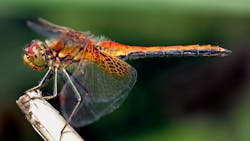Researchers eye algorithms to enable hypersonic missiles to hunt their prey as efficiently as dragonflies
CITY, state – Dragonflies — a common sight in spring and summer — may be key to developing more precise and maneuverable hypersonic missiles. National Defense magazine reports. Continue reading original article
The Military & Aerospace Electronics take:
3 Oct. 2019 -- The creatures are able to catch 95 percent of their prey, designating them as one of the world’s top predators. Now, Sandia National Laboratories is researching how it can apply a dragonfly’s technique to missiles, says Frances Chance, a computational neuroscientist at Sandia.
The insects take about 50 milliseconds to react to prey despite their limited vision, Chance noted. The project is part of Sandia’s autonomy for hypersonic research campaign. “They’re very good hunters … but they have limited vision,” she says.
Chance is building a computational model to examine what a dragonfly does when it is intercepting its prey and how its nervous system reacts. The model, which is slated to be completed in October, could later become more complex, she noted. Algorithms gathered from the research could be integrated onto high-speed weapons, such as hypersonic vehicles, which are characterized by their ability to move at speeds of Mach 5 or faster.
Related: DARPA NAV program seeks to make insect-like surveillance UAVs a reality
Related: Scientists to develop miniature military robots
Related: Micro UAVs to make substantial impact over next few years
John Keller, chief editor
Military & Aerospace Electronics
